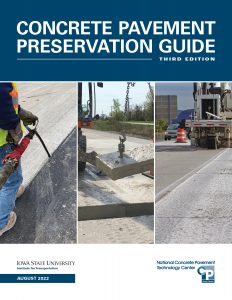InTrans / Aug 25, 2022
CP Tech Center publishes new edition of Concrete Pavement Preservation Guide

Chain lift-out method of slab removal (John Donahue, MoDOT, used with permission)
Pavement preservation is often described as “providing the right treatment to the right pavement at the right time.”
To help highway agencies put that maxim into practice on their concrete pavement networks, the National Concrete Pavement Technology Center (CP Tech Center) recently released the third edition of its Concrete Pavement Preservation Guide.
This edition of the guide—which provides guidance and information on the selection, design, and construction of cost-effective concrete pavement preservation treatments—reflects advancements and new developments in the concrete pavement preservation arena that include the following:
- Information on new pavement evaluation equipment, technologies, and protocols
- Information on new materials and techniques for partial-depth repairs (PDRs)
- New information on full-depth repairs (FDRs), including updated information on precast and utility cut repairs
- Updated information on diamond grinding and grooving, including information on slurry-handling procedures
- An updated chapter on joint sealing with an introduction to the use of surface sealers
- An abbreviated chapter on concrete overlays with links to detailed information in the Guide to Concrete Overlays (4th edition), published by the CP Tech Center in November 2021
- Discussion of general sustainability considerations in the selection of pavement preservation treatments
“Several concrete pavement preservation treatments are available to meet a range of conditions,” said the guide’s project manager Steven Tritsch, an associate director at the CP Tech Center. “These treatments are often applied in combination to address several deficiencies and to maximize overall effectiveness—and when applied in a timely fashion, preservation treatments can also significantly improve pavement performance and extend service life.”
The guide focuses primarily on preservation treatments that are applicable at the project level rather than at the network level and addresses such issues as prioritizing and budgeting.
“Effective pavement management programs are critical in identifying and forecasting the need for timely pavement preservation treatments, and that important link between forecasting need and optimal pavement management is highlighted in this guide,” said Tritsch.
The guide was published with funding from and as part of the Federal Highway Administration (FHWA) cooperative agreement Advancing Concrete Pavement Technology Solutions.
It is aimed at state and local design and material engineers, construction managers, quality control personnel, contractors, material producers and suppliers, technicians, and tradespeople who have some familiarity with concrete pavement maintenance and pavement preservation treatments. However, the guide is expected to also be of value to those who are new to the field.
In addition to the Concrete Pavement Preservation Guide (Third Edition), the CP Tech Center has developed a set of resource materials to train and educate users on the applications and benefits of pavement preservation. These pavement preservation resources are available at https://cptechcenter.org/pavement-preservation/.
